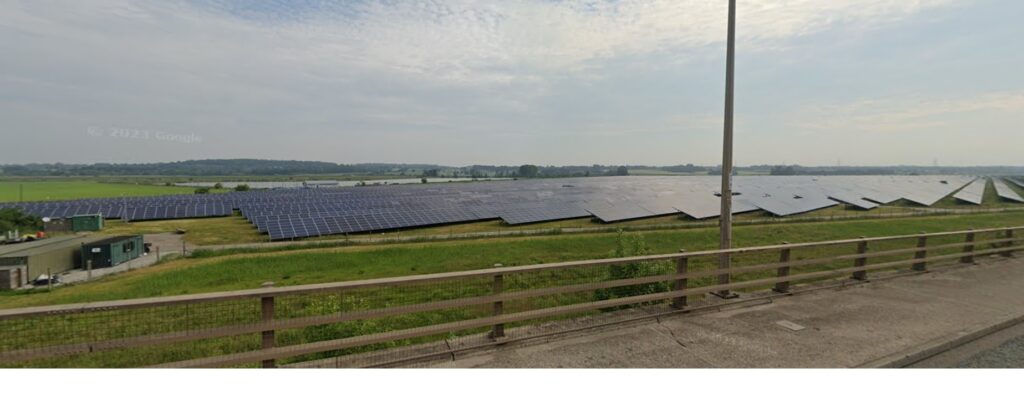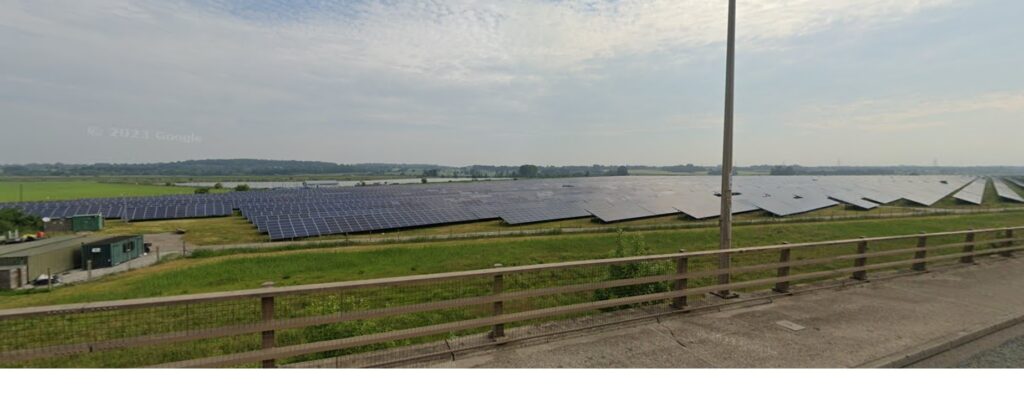


What is a Solar Farm?
A solar farm, also known as a photovoltaic (PV) power station, is a large-scale installation of PV solar panels that capture sunlight and convert it into electricity.
PV solar panels are made of semiconductor materials, such as silicon, that generate electric current when exposed to light. The electric current from the panels is then fed into an inverter, which converts it from direct current (DC) to alternating current (AC), the standard form of electricity used in homes and businesses for their appliances. The AC electricity is then transmitted to the National Grid, where it can be distributed to consumers or stored in solar battery storage for later use.
Solar farms are a clean & renewable source of energy that can reduce greenhouse gas emissions and fossil fuel dependence. According to the International Energy Agency, solar power accounted for about 3% of global electricity generation in 2020, and is expected to grow significantly in the coming years.
The Pros of Solar Farms
Solar energy is an exciting renewable source of energy that relies on the abundant and constant sunlight that reaches the earth’s surface. Unlike fossil fuels, which are finite and polluting, solar energy does not deplete natural resources or emit greenhouse gases.
Solar energy can be converted into electricity using solar panels, which are devices that contain photovoltaic (PV) cells that generate electric current when exposed to light. Solar panels can be installed on rooftops, buildings, or large areas of land, forming solar farms.
Solar farms are collections of interconnected solar panels that can produce large amounts of electricity for homes, businesses, and industries. According to the Solar Trade Association, there were over 400 solar farms in the UK as of 2020, with a total capacity of more than 5 gigawatts.
Solar energy is one of the fastest-growing and most promising sources of clean energy in the world. According to the International Renewable Energy Agency, global solar power capacity increased by more than 20% in 2020, reaching 714 gigawatts.
Some of the largest countries and economies in the world, such as China, the US, India, Japan, and Germany, have invested heavily in solar power development and deployment. Solar energy can be harnessed and utilized in almost any part of the world, as long as there is sufficient sunlight. However, some regions have more favourable conditions and higher potential for solar power generation than others. For example, Australia has one of the highest solar radiation levels in the world, and is expected to reach 50% renewable electricity by 2025. The UK, on the other hand, has lower solar radiation levels and more variable weather, but still benefits from solar power as a reliable and cost-effective source of electricity.
The Cons of Solar Farms
Solar farms require a significant upfront investment, as they need to obtain and process rare and precious materials, such as silver, to manufacture the solar photovoltaic (PV) panels that convert sunlight into electricity. Silver is used as a conductor in the solar cells, and it accounts for about 6% of the total cost of a solar panel.
However, once the solar farm is operational, it can generate clean and renewable energy without emitting any greenhouse gases or pollutants. This means that solar farms can offset the environmental impact of their production and contribute to reducing the global carbon footprint.
According to a study by the International Renewable Energy Agency, solar PV systems can save between 1.5 and 2.7 tonnes of carbon dioxide per year for each kilowatt of installed capacity. Solar energy is also becoming more affordable & competitive, as the cost of solar panels has dropped by more than 80% since 2010. If you are interested in installing solar panels or a solar farm, you can contact NXTGEN Energy for professional advice, information, or a free no-obligation quote.
The Largest Solar Farm in the World
Solar farms are large-scale installations of solar photovoltaic (PV) panels that capture sunlight and convert it into electricity. Solar farms are usually located in rural areas where there is plenty of open space and solar radiation. One of the most impressive examples of solar farms is the Bhadla Solar Park, which is the largest solar power plant in the world as of 2023.
The Bhadla Solar Park is situated in the Thar Desert of Rajasthan, India, covering an area of 56 square kilometres across five remote villages. The solar park consists of 37 separate solar plants that have a total installed capacity of 2,245 megawatts (MW). The solar park was developed by the Rajasthan Renewable Energy Corporation Limited (RRECL), a joint venture between the Government of Rajasthan and the Ministry of New and Renewable Energy (MNRE). The construction of the solar park started in 2016 and required an investment of $1.4 billion.
The Bhadla Solar Park is part of India’s National Solar Mission, which aims to install 100 gigawatts (GW) of solar power by 2022. The solar park contributes to India’s renewable energy goals and helps reduce its carbon emissions by an estimated 4 million tons per year. The solar park also provides clean and reliable electricity to the region, creating about 10,000 direct and indirect jobs during construction and operation. The solar park currently accounts for 10 per cent of the total power consumption in Rajasthan, making it a significant source of energy for the state.
Solar Farms in the UK
Solar farms are not only found in distant and sunny places, but also in the UK, where they can provide clean and affordable electricity to thousands of homes. One way to measure the output of a solar farm is by its installed capacity, which is the maximum amount of electricity it can produce at a given time. The average installed capacity of a solar farm in the UK is about 5 megawatts (MW), which means it can power about 1,500 homes for a year. To install 5 MW of solar panels, a solar farm needs about 25 acres of land, which is equivalent to about 20 football pitches.
People who live in solar-powered households can enjoy many benefits from using solar energy, such as:
- Saving money on their electricity bills by using a cheaper, renewable, and low-maintenance power source. Solar energy can also help reduce fuel poverty, which is the inability to afford adequate heating and lighting. According to the UK government, about 10% of households in England were in fuel poverty in 2019.
- Reducing their environmental impact by sourcing their power locally and avoiding the use of fossil fuels, which are finite, polluting, and contribute to climate change. Solar energy does not emit any greenhouse gases or harmful substances, and has a low carbon footprint compared to other energy sources. According to a study by the University of Exeter, solar farms in the UK can save between 94 and 105 grams of carbon dioxide per kilowatt-hour of electricity generated.
- Taking advantage of the UK’s windy weather, which can help cool down the solar panels and increase their efficiency. Solar panels work best when they are not too hot, as high temperatures can reduce their performance and lifespan. The UK’s average wind speed is about 9.6 miles per hour, which is higher than many other countries with more solar power capacity.
The Largest Solar Farm in the UK
The largest solar farm in the UK is located in Flintshire, Wales, near the border with England. It is called Shotwick Solar Park and it was commissioned in March 2016 by a joint venture between We-Link Energy and the Compton Group.
- Shotwick Solar Park has a capacity of 72.2 megawatts (MW).
- Shotwick Solar Park covers an area of 250 acres.
- Shotwick Solar Park consists of 277,728 solar panels.
- Shotwick Solar Park produces enough electricity to power 18,055 average households every year.
- Shotwick Solar Park saves 22,500 tonnes of CO2 emissions annually.
But what makes Shotwick Solar Park unique is that it is not connected to the National Grid. Instead, it has a private wire connection to the nearby UPM Shotton Paper Mill, which is the UK’s largest paper mill that uses 100% recycled paper. A private wire connection is a direct link between a renewable energy generator and a consumer, bypassing the public network like the National Grid and saving on transmission and distribution costs.
Shotwick Solar Park supplies 70% of the paper mill’s energy needs, saving the business 22,500 tonnes of CO2 emissions annually. This helps UPM Shotton Paper Mill reduce its environmental impact and maintain its competitive edge in the international market of paper production. Shotwick Solar Park is also the largest private wire solar park in Europe.
Shotwick Solar Park is a shining example of how solar energy can benefit both businesses and the planet. It shows how large-scale solar farms can provide green, reliable and cost-effective power to industrial consumers, while also supporting local jobs, local communities and local wildlife.

Do you have land for a Solar Farm?
The UK is now home to hundreds of solar farms that are transforming the way we produce and consume energy. They are not only providing green, renewable and locally sourced power to millions of homes and businesses, but also creating jobs, supporting communities and enhancing biodiversity. Solar farms are a win-win solution for the environment and the economy. Do you have land in the UK that could be suitable for a solar farm? If so, we would love to hear from you! We are looking for landowners who share our vision of powering the UK on solar energy. Together, we can make a difference, by building more solar farms that benefit everyone in not only the short-term, but also in the long-term.


 Solar Farms: What Are They and W...
Solar Farms: What Are They and W...



